AMSTERDAM- It's early morning and as usual Amsterdam Centraal is crowded with commuters. Each day, more than 300,000 people pass through the castle-like railway station and it seems like all 300,000 are huddled together on the main platform as I exit the train from Schiphol Airport.
How am I ever going to find Yvonne - the Dutch friend who is taking me on a walking tour of Amsterdam - in this crowd?
As I wade through the sea of humanity trying to reach the main entrance - maybe Yvonne will be waiting there - I'm jostled by commuters rushing to work and jolted by foreign backpackers trying to get their bearings.
A half-finished cup of Starbuck's mocha java suddenly lands at my feet.
"Verdoemen (damn)," curses the man who drops it, before disappearing into the crowd.
A tap on my right shoulder makes me twirl around. Yvonne has magically appeared.
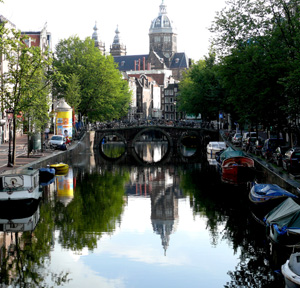
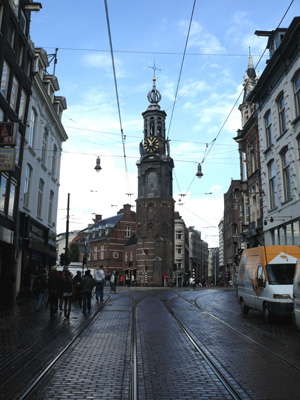
Above: Amsterdam's canals and old buildings have inspired painters and poets.
"I've been watching for you from a safe distance," says Yvonne, who takes me by the arm and leads me through the insanity to a quiet square just outside the beautiful railway station that opened in 1889 and remains one of Amsterdam's loveliest landmarks.
People rush past us speaking every language imaginable - "there are 150 nationalities living in Amsterdam and they speak 145 languages," the informative Yvonne tells me.
The best way of touring compact Amsterdam is aboard one of the flat-bottom canal boats or on foot. But, "walking costs you nothing," the fit Yvonne rationalizes.
So we ignore the flotilla of canal boats tied up at the pier opposite Amsterdam Centraal and make our way across the web of roads and tram tracks that snake around the great station to a street (Warmoesstraat) where a handsome house wrapped in dark wood stands.
"This is where I always start my tours of Amsterdam with friends," says Yvonne as we reach Olofspoort Gate (named in honour of former Norwegian King Olif).
"There are only two homes made of wood left in Amsterdam and this is one of them," says my friend, who tells me after 1452 the city, concerned about fires, decreed all homes be made of brick or stone.
With our walk officially under way, I follow in Yvonne's footsteps through the narrow streets and passages around Olofspoort and soon we emerge in the city's small, but impressive Chinatown. Yvonne is anxious to introduce me to the fishmonger working in the Amsterdamsche Vischandel, a seafood shop located on the edge of Chinatown where fresh herring (best caught in June, according to Yvonne) is displayed on a bed of ice in the window.
No tour of Amsterdam would be complete without a walk through the city's famed "Red Light" district, where Amsterdam's smallest street, Tomptersteeg, is located.
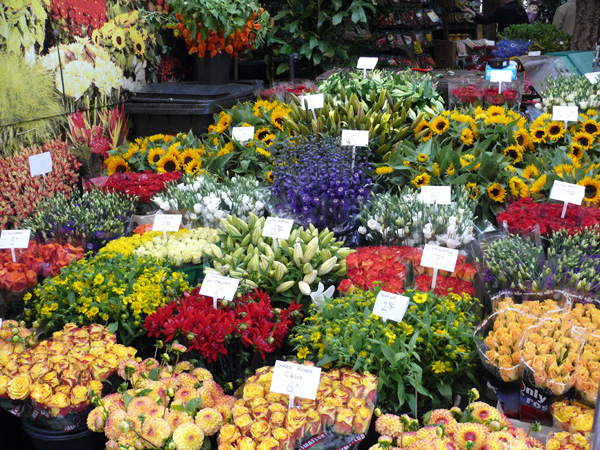
Above: Amsterdam's flower market is one of the most popular tourist sites.
"So let's get it over with," huffs Yvonne.
Tomptersteeg, a shoulder-width wide lane, is lined with lots of doors with fluorescent red lights hanging over them, signaling the occupants are open for business. It may be a seedy area but one which still attracts lots of curious tourists.
Yvonne just laughs at the "window shoppers."
"Prostitutes have been a part of Amsterdam since the 1400s," says Yvonne. "The men would come back from the sea very lonely, you know"
As we walk, my friendly guide points to the city's famed gable homes, most of which are so narrow they come with hoisting beams and fronts slanted toward the street so furniture and other heavy objects can be delivered through upper windows, thus avoiding the almost impassable winding staircases within.
When we reach the Nieuwmarkt, the old market square where one of the city's medieval gates are located, Yvonne says the weigh house (De Waag) standing there was once used to collect taxes from cargo ships coming into Amsterdam. De Waag was also where Rembrandt lived for several years and where he painted his famed portrait, "The Anatomical Lessons of Professor Tulp" in 1632 - inspired by the anatomical lessons student surgeons received on the premises.
The outdoor market, filled with cheese, vegetable and bread stalls, is a favourite with locals and tourists alike, and the quaint cafes that ring the square are perfect places to rest for a while over a cup of coffee or glass of beer.
While sipping a cup of strong coffee and nibbling on some wonderful Amsterdam cheese we bought in the market, Yvonne tells me her city, during the Dutch Golden Period of the 17th century, was enormously wealthy and home to the world's first stock exchange.

Above: Even the Red Light district is a tourist draw.
"Bonds were sold to citizens to help finance the long and dangerous sea voyages to Asia and other parts of the world. When the ships returned filled with riches, the cargo was sold off and the investors paid - some making as much as 400 per cent profit on their investment," says Yvonne, who quickly adds, "of course, a lot of ships never did return - they were lost to storms or pirates."
Amsterdam's skyline is dotted with many handsome spires that rise high above great churches. One of the most impressive is the Zuiderkirk (South Church), which was completed in 1614 and was one of the first protestant churches built after the Reformation.
The labyrinth of streets and courtyards surrounding South Church, whose tower leans a bit to the right after standing so many years on soft ground, are a delight to explore.
We emerge from one of those small streets onto Jodenbree, a wide boulevard bordered on one side by the city's old Jewish Quarter and on the other by a picturesque sea lock - one of 16 still operating in Amsterdam. The lockkeeper's former home now serves as a quaint pub.
When we reach the house at No. 4 Jodenbree, Yvonne tells me we have arrived at the entrance of another of Rembrandt's homes, where he painted his Dutch masterpieces, many of which still hang at the city's famed Rijksmuseum.
Just behind Jodenbree, we discover Waterloo Markt, a neighbourhood flee market which has been operating daily on this site since 1875. An eclectic group of entrepreneurs is selling lots of "antique" memorabilia.
A sweet perfume hangs over the market.
"That's the smell of cannabis coffee," says Yvonne, who warns me not to purchase the cannabis lollipop one vendor is pushing at me.
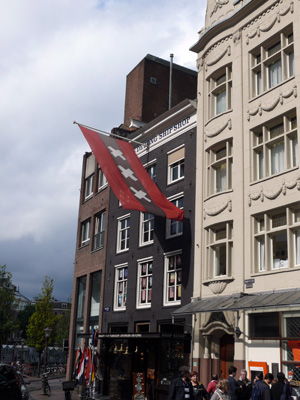
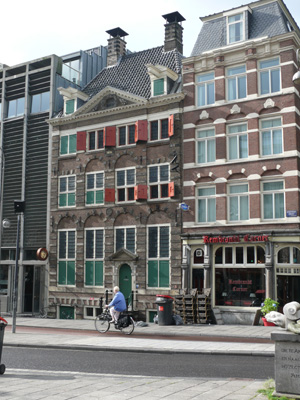
Above: Everywhere you look in Amsterdam, history looks back.
Although the lollipops, with just a small amount of marijuana inside, make amusing gifts for friends, "your customs official back home may not see the humor in your purchase," cautions Yvonne.
Amsterdam's Jewish Quarter was home to over 100,000 Jews before World War II, but after Hitler's reign of terror, the neigbourhood was reduced to just 5,000 Jewish residents. The massive Portuguese Synagogue we come upon at the end of Waterloo Markt is a replica of the great synagogue in Jerusalem. Portuguese Jews, it seems, played a key role in the cultural and economic development of Amsterdam in the early days and the handsome synagogue, completed in 1675 and which remains active today, stands as a reminder of their wealth and status.
As we exit the Jewish Quarter, we stop on a small stone bridge that crosses the Amstel River, from where the city gets its name. Yvonne points to a lovely building reflected in the Amstel and tells me it once served as a hostel for widows back in the 16th century. The red-brick building, known as the Amstelhof (it means "Court on the Amstel" in Dutch), is now home to the Amsterdam Hermitage, the Dutch branch of the famed Russian museum in St. Petersburg.
As tour boats slowly past under the arched bridge, Yvonne tells me there's over 120 kilometres of canals snaking through this remarkable city that sits almost seven metres below sea level at its lowest point.
The Singel, built in the late 15th century, is the largest of Amsterdam's canals, which are now recognized as UNESCO World Heritage Sites. The Gentleman's, the Empress and the Prince are the city's other famous canals.
Dark clouds that suddenly appear overhead are a warning to Yvonne that we should take shelter because rain in imminent. We duck into a café in Rembrandt Square, dominated by a statue of this country's greatest artist, and as raindrops attach themselves to stain glass windows, Yvonne says the building standing behind Rembrandt's cast iron likeness is the Amsterdam school of architecture, and that the building down the street with the wonderful Art Deco façade is actually the Theatre Tuschinsky, which dates back to the early 1900s.
After the rain stops, we resume exploring streets that we share with cyclists - there are over 1 million bikes in this city of about 700,000 people - and trams. Near the city's floating flower market - it actually straddles a canal - a building with the lovely tower but blackened by time catches my attention.
"That was once Amsterdam's mint," says Yvonne. "The rich people back in the Golden Age actually had their own money minted here. The building dates back to the 1620s and is now one of our 40 museums." Our walk through the floating flower market is delightful - tourists are purchasing tulip bulbs to take home and locals are getting their daily flower arrangements.
On nearby Nes Street, the city's old financial district where modern banks have set up their headquarters, Yvonne tells me the building with the Stads-Bank van Lening sign hanging on its brick facade, was the first financial institution in the world to issue consumer loans back in 1614. The street was also home at one time to the world's first stock exchange building. This is also the area of the city where America's pioneer leaders, Thomas Jefferson and John Adams lived when they came to seek loans from the Dutch to help finance the Louisiana Purchase.
Our walk through the Centrum, Amsterdam's Central District, also includes stops at the Leidgestraat, the entertainment district where you fine lots of wonderful ethnic restaurants - Indonesian food in the Dutch capital is the best outside Asia - and the museum district, where major museums like the Rijksmuseum and Van Gogh museum are located.
After hours of walking, we end up in Dam Plein, the city's main square which is dominated by the Dutch Royal Palace and other historic buildings.
It's time to bid Yvonne adieu - she has a late afternoon appointment with her dentist. But she encourages me to continue my tour alone, suggesting I visit Amsterdam's cruise ship terminal behind Amsterdam Centraal, where large ocean-going cruise ships and river boats that cruise Europe's great rivers tie up.
Amsterdam is one of the friendliest cities in Europe to tour and walking it allows you to visit things you'll never see from the deck of a cruise boat.
Information
· For more on Amsterdam and the Netherlands, go to www.holland.com.
· KLM offers daily flights to Amsterdam from Toronto.
· The Netherlands is the only country in the world to have two national capitals - Amsterdam is the country's "traditional" capital while The Hague a short distance away is the current "political" capital for the Dutch.
· Best times of year to visit Amsterdam are the spring or fall - summers are crowded with tourists and heat can be a problem.